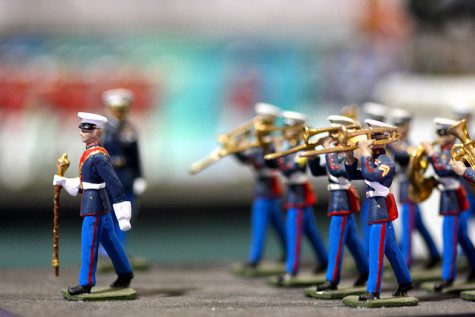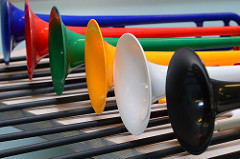
The first time I ever saw a marching band I ran away and cried. The band wasn’t even really marching–it was cooped up inside a small music hall. Maybe that was the problem. The timpani and the tubas, trapped in a single room, were far too loud for a little kid’s ears.
When I finally saw the same band, a few years later, it was marching across a college football field. I remember being worried. But this time, when they started to play, they swirled and spun, together looking like a series of falling dominoes, an expanding square, even an enormous flag. This time, the drums sounded like the faint pops of champagne corks in the enormous stadium.
Marching bands have always seemed like an odd mix of precision and chaos. The only thing I know about them are from halftime shows—perfect coordination plus the occasional breakdance set to fight songs and blockbuster themes—and from the movie American Pie. In college, I heard rumors that band parties were some of the wildest ones on campus. My lab partner, a trombone player, could synthesize aldehydes and do kegstands with ease. (Chemistry and marching bands always seem to go together, maybe because in my first semester, the band broke into the lecture hall while the professor performed a titration that changed Stanford’s red and white to Cal’s blue and gold.)
 I’ve become interested in bands recently because I know a four-year-old who became obsessed with marching after watching The Music Man. He’s got a uniform, a bandleader’s baton, and a tiny trombone kazoo; he marches to and fro, whether he has his outfit on or not. If this carries on, I started to wonder, what does the future hold for him?
I’ve become interested in bands recently because I know a four-year-old who became obsessed with marching after watching The Music Man. He’s got a uniform, a bandleader’s baton, and a tiny trombone kazoo; he marches to and fro, whether he has his outfit on or not. If this carries on, I started to wonder, what does the future hold for him?
Any future band member, I learned, needs to be in good shape. One study of a championship high school marching band found that marching was as strenuous as playing a sport. The band members are always moving, often running, and carrying instruments that may weigh up to 40 pounds, the study author said. One Indiana State University drum player’s heart rate sped up to more than 200 beats per minute on the field. (There’s also the small risk of a band member becoming part of the game itself.)
I might have to be cautious about band camp, too, and not just for the extracurricular activities. Noise levels at one high school band camp often surpassed safe levels for hearing loss prevention, sometimes by more than 800 percent.
But those who love both marching and math have fascinating career options. One California man has transformed his passions for both into full-time work as a drill designer, someone who choreographs the complicated, creative patterns that bands execute so seamlessly on the field.
The results of this beautiful precision can be seen on fields across the country under the Friday night lights (or Saturday afternoon sunshine). A halftime show can get kids cheering, quiet a rowdy crowd, and even inspire tears of a different kind. I was talking to a friend about watching a recent parade. She told me that seeing marching bands always makes her cry. It’s that they worked so hard, she said, to be so unified, to play and march as one. And I imagine that someday, I’ll be crying at a marching band, too—just like the men and women of River City when they first hear their children play, no matter how the music sounds.
—
Images by Kevin Dooley and ACE Foundation via Flickr/Creative Commons